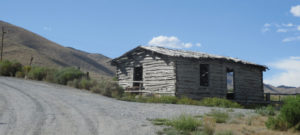
Located at the southern end of Ruby Valley and 65 miles from Elko, Ruby Lake National Wildlife Refuge is a great place for an outdoor adventure in September. Once the bed of 200-foot deep Franklin Lake, it is now a network of spring-fed marshes and shallow ponds, meadows, and sage brush stands that provides habitat for one native fish, hundreds of species of native and migratory birds, and dozens of mammals. One of the biggest springs feeds Cave Creek which is by the refuge headquarters. A short hiking trail takes you to the source which flows from a limestone cave. Since the mid-1900s the waters have been stocked with trout and bass. The refuge offers bird watching, waterfowl hunting, fishing, wildlife viewing, boating, bicycling, historical exploration, and auto touring.
Stocking of bass began in the 1940s to create sport fishing opportunities and Rainbow Trout, Brown Trout, and Brook Trout were later stocked to provide additional fishing opportunities. The Gallagher State Fish Hatchery, located on the Refuge, still stocks Rainbow Trout and Tiger Trout in the collection ditch and several ponds on the south end of the Refuge to sustain fishable populations.
Numerous species of waterfowl nest on this refuge as well as a variety of other water-dependent birds such as Coots, Trumpeter Sans, Grebes, Sandhill Cranes, Great Blue Herons, Black-crowned Night Herons, White-faced Ibis, Black-necked Stilts, avocets, Yellow-headed Blackbirds, Common Yellowthroats, and Marsh Wrens. Long-billed Curlew nest in the meadows along with Gadwall ducks and Cinnamon Teal. Sage Grouse nest in the sagebrush shrub steppe and forage in meadows and grasslands where Burrowing Owls raise their young in abandoned badger dens.
Mule Deer and pronghorn are often seen in the meadows on the Refuge. Rocky Mountain Elk, which spend most of their time in the surrounding mountains out of view, are sometimes seen in early morning or evening feeding or wallowing in the lush meadows. Coyotes are numerous and often seen or heard howling at dusk. Muskrats are often observed on the marsh during daylight hours. Badgers, Long and Short-tailed Weasels, Mink, and numerous small mammal species inhabit the Refuge but are rarely seen. Pygmy Rabbits are reclusive residents of dense sagebrush stands while Western Cottontail rabbits and Black-tailed Jackrabbits are more easily observed.
The area’s rich human history, which goes back thousands of years provides opportunity for historical exploration. The refuge is in the homeland of the Shoshone people who have lived in the Great Basin for thousands of years. Educational panels located throughout the refuge help interpret the Shoshone’s cultural history. In the late1800’s settlers began moving into the valley and the Bressman cabin is a reminder of this era. At the southern end of the refuge is the Fort Ruby historic site. The fort was manned from 1862 to 1869 to protect overland mail and stage route. Today, a walking path and interpretive panels highlight the fort history.
Know before you go – The refuge is one of the remotest refuges in the lower 48 states and there are no services. It is best to plan ahead to ensure a safe and fun trip. Make sure you gas up in town, bring extra food and water, and that your vehicle is outfitted for backcountry driving. Cell service is not available, but luckily a pay phone is still working at Shantytown. Call the refuge headquarters to find out conditions on local weather, boating rules, and road conditions. (775) 779-2237 or RubyLake@fws.gov